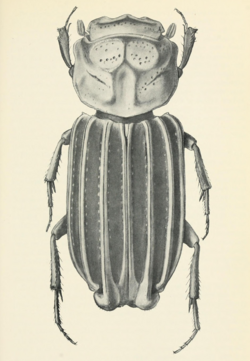Biology:Cartwrightia
| Cartwrightia | |
|---|---|

| |
| C. intertribalis, illustrated by Elsie Herbold Froeschner | |
| Scientific classification | |
| Domain: | Eukaryota |
| Kingdom: | Animalia |
| Phylum: | Arthropoda |
| Class: | Insecta |
| Order: | Coleoptera |
| Family: | Scarabaeidae |
| Subfamily: | Aphodiinae |
| Genus: | Cartwrightia Islas, 1958 |
| Type species | |
| Cartwrightia intertribalis Islas, 1958
| |
| Species | |
| |
Cartwrightia is a genus of scarab found in Latin America. It was named and circumscribed in 1958 by Federico Islas Salas. (As of 2017), three species are recognized: C. intertribalis, C. cartwrighti, and C. islasi. They can be found in the nests of leafcutter ants or in dung.
Taxonomic history
The Mexican entomologist Federico Islas Salas circumscribed the genus Cartwrightia in 1959 for his newly-described species C. intertribalis.[1] The generic name is in honor of the American entomologist Oscar Ling Cartwright.[2] In 1967, Cartwright himself described two additional species in this genus: C. islasi, whose specific name honors Islas, and C. cartwrighti, which Cartwright named after his brother.[1]
Taxonomy
Cartwrightia is in the subfamily Aphodiinae of the scarab family Scarabaeidae, although entomologists are not all in agreement as to which tribe it should be placed in. American entomologist Paul E. Skelley ({{{2}}}) has described this genus as "unusual", "distinct", and in need of additional study as to its taxonomic classification.[3] Its characteristics are similar to those of various tribes, including: Eupariini, Odontolochini, and Rhyparini.[3]
In 1967, Cartwright wrote this genus "superficially appears most closely allied to Rhyparus in the tribe Rhyparina", but placed this genus in the tribe Eupariina.[1] Others who have placed it in Eupariina include the Italian entomologist Marco Dellacasa ({{{2}}}),[4] the American entomologist Henry Fuller Howden (nl) and the Canadian-Australian entomologist Ross I. Storey ({{{2}}}),[5] Skelley,[3] and Mexican entomologist Pablo Minor ({{{2}}}).[6]
Zdzisława Teresa Stebnicka ({{{2}}}) and colleagues, however, disagreed with this, placing it in Rhyparini[7] as the mouthparts and head shape exclude it from the tribe Eupariini.[8][4] The Swedish entomologists Hege Vårdal and Mattias Forshage have also placed this genus in Rhyparini.[9]
Description
Beetles in this genus are 3–4 mm (0.12–0.16 in) long and have elongate, somewhat flat bodies which are rufous in color.[3] They have elongated mesocoxa and their mesothorax lateral sclerites are hidden.[10] This genus is also characterized by bulbous formations at the posterior tips of their elytra and depressions on their pronotum.[1]
Distribution
Cartwrightia are found in Mexico, Central America, and South America. C. intertribalis have been found in Mexico, C. islasi have been found in Mexico, Guatemala, and El Salvador, and C. cartwrighti are found throughout tropical South America.[3]
Biology
Cartwrightia species are myrmecophilous[5] and ant inquilines.[9] C. islasi have been found in the nest of the leafcutter ant Atta cephalotes.[1][7] C. islasi and C. cartwrighti have also been found in dung.[11][12]
References
- ↑ Jump up to: 1.0 1.1 1.2 1.3 1.4 Cartwright, Oscar L. (1967). "Two New Species of Cartwrightia from Central and South America (Coleoptera: Scarabacidae: Aphodiinae)". Proceedings of the United States National Museum 124 (3632): 1–8. doi:10.5479/si.00963801.124-3632.1. BHL page 7510625. https://library.si.edu/digital-library/book/proceedingsofuni1241968unit.
- ↑ Spangler, Paul J. (1985). "Oscar Ling Cartwright: 1900–1983". Proceedings of the Entomological Society of Washington 87 (3): 692. https://biodiversitylibrary.org/page/16218991.
- ↑ Jump up to: 3.0 3.1 3.2 3.3 3.4 Skelley, Paul (2008). "Cartwrightia Islas 1958". in Ratliffe, Brett C.; Jameson, Mary Liz. University of Nebraska State Museum - Division of Entomology. http://museum.unl.edu/research/entomology/Guide/Scarabaeoidea/Scarabaeidae/Aphodiinae/AphodiinaeTribes/Eupariini/Cartwrightia/Cartwrightia.html.
- ↑ Jump up to: 4.0 4.1 Stebnicka, Zdzisława T. (2009). The Tribe Eupariini of New World (Coleoptera: Scarabaeidae: Aphodiinae). Iconography. II. Kraków: Institute of Systematics and Evolution of Animals, Polish Academy of Sciences. p. 11. ISBN 978-83-61358-00-8.
- ↑ Jump up to: 5.0 5.1 Howden, Henry F.; Storey, Ross I. (1992). "Phylogeny of the Rhyparini and the new tribe Stereomerini, with descriptions of new genera and species (Coleoptera; Scarabaeidae; Aphodiinae)". Canadian Journal of Zoology 70 (9): 1819–1820. doi:10.1139/z92-248.
- ↑ Minor, Pablo (2017). "New state records and updated checklist of Aphodiini and Eupariini (Coleoptera: Scarabaeidae: Aphodiinae) from Mexico". Zootaxa 4244 (4): 511. doi:10.11646/zootaxa.4244.4.3. PMID 28610098.
- ↑ Jump up to: 7.0 7.1 Galante, Eduardo; Stebnicka, Zdzisława; Verdú, José Ramón (2003). "The Aphodiinae and Rhyparinae (Coleoptera: Scarabaeidae) in southern states of Mexico (Chiapas, Oaxaca, Puebla and Veracruz)". Acta Zoologica Cracoviensia 46 (3): 309. http://db.isez.pan.krakow.pl/AZC/pdf/azc_i/46(3)/08.pdf. Retrieved 2017-11-17.
- ↑ Stebnicka, Zdzisława T. (2007). "New species of Iarupea Martínez and morphological specializations among related taxa associated with ants and termites (Coleoptera: Scarabaeidae: Eupariini)". Revue suisse de Zoologie 114 (3): 586. doi:10.5962/bhl.part.80404. https://biodiversitylibrary.org/page/41185168.
- ↑ Jump up to: 9.0 9.1 Vårdal, Hege; Forshage, Mattias (2010). "A new genus and species and a revised phylogeny of Stereomerini (Coleoptera, Scarabaeidae, Aphodiinae), with notes on assumedly termitophilic aphodiines". ZooKeys (34): 64, 66, 70. doi:10.3897/zookeys.34.264.
- ↑ Skelley, Paul E.; Howden, Henry F. (2003). "A new species of Lomanoxia Martinez from Costa Rica (Coleoptera: Scarabaeidae: Aphodiinae)" (in en). Insecta Mundi 17 (3–4): 185. http://journals.fcla.edu/mundi/article/view/25034.
- ↑ Kirk, A. A. (1992). "Dung beetles (Coleoptera: Scarabaeidae) active in patchy forest and pasture habitats in Santa Cruz province, Bolivia, during spring". Folia Entomológica Mexicana 84: 54. http://www.socmexent.org/revista/folia/Num%2084/45-54.pdf. Retrieved 2017-11-17.
Wikidata ☰ Q14897939 entry
 |

